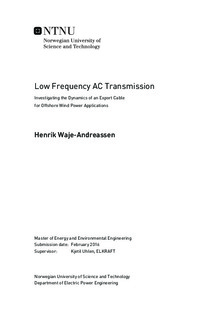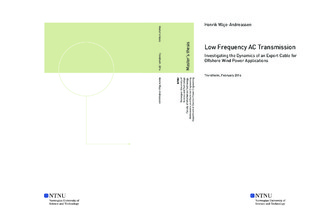| dc.description.abstract | In the following thesis, the properties of a 16 2/3 Hz, low frequency alternating current (LFAC) export cable was examined in both steady state and dynamic conditions, as part of a simplified offshore transmission system. Simulations were performed for both LFAC and conventional 50 Hz high voltage alternating current (HVAC) systems for comparison purposes. Introductory to the simulations, different cable models were investigated. Using MATLAB/SIMULINK SimPowerSystems, the use of the built-in distributed parameters model (DPM) was considered the best option for simulation, especially when studying the power cable in dynamic situations. For steady state conditions, the utilization of the series pi-model showed satisfying results, e.g. when the effect of voltage rise in a lightly loaded or unloaded transmission system was studied (Ferranti effect). The results revealed a significantly lower voltage increase across the LFAC cable compared to a conventional HVAC cable. Thus, in the case of sudden disconnections or loss of load, the risk of damaging transmission system components can be lower for an LFAC system compared to an HVAC system.
Charging currents were observed to be lower and less sensitive to cable length variations for an LFAC cable compared to an HVAC cable. Thus, more active power is allowed to be transmitted in the LFAC cable. During energization of the cable, the LFAC voltages and currents experienced temporary transient distortions of the waveform before stabilizing at steady state, whereas the same distortions were not observed for the HVAC system.
Transient distortions were also observed in the fault analysis for different short circuit (SC) events; three phase to ground, double phase to ground and phase to phase faults. The fourth SC event, the single phase to ground fault, showed very little distortion. However, the highest direct current (DC) offset magnitude was observed for the phase to ground voltages posterior to this fault.
DC offsets were also observed after clearing the three phase to ground fault and double phase to ground fault, resulting from the lack of grounding in the cable system. The DC offsets were present for a long period of time; up to 100 seconds depending on the type of fault, and the magnitude of the DC offsets was significantly higher for the HVAC system. Connecting the cable's end terminal to ground through a shunt reactor resulted in a far lower DC offset magnitude which was rapidly damped to zero. Similar oscillations were observed for the HVAC system, and the DC offset was damped faster in this case due to higher resistance in the cable. The frequency of the oscillations were 30 Hz for the LFAC system and 44 Hz for the HVAC system, and it should be examined whether such oscillations may contribute to resonance in the power system. Possible measures to increase the damping of the oscillations would be a better optimization of the shunt reactor.
Common for the dynamic situations investigated was the presence of harmonic distortion after switching operations or faults/clearing of faults. In the case of switching operations, the problem of transient distortion could possibly be more prominent for LFAC transmission systems compared to HVAC systems. However, further studies should be carried out before making final conclusions on this topic. In summary, the LFAC cable showed promising results in terms of overvoltages under steady and dynamic situations compared to a conventional HVAC system. | |

